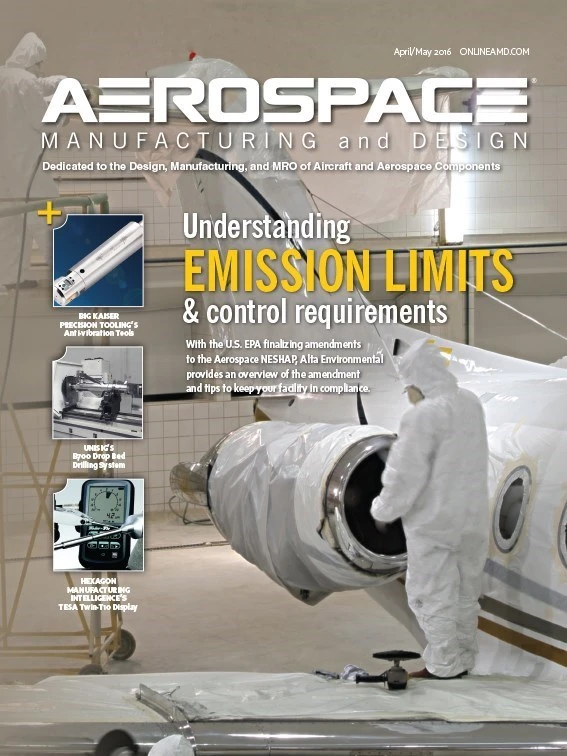
On Dec. 7, 2015, the United States Environmental Protection Agency (EPA) finalized the residual risk and technology review (RTR) and published final amendments to the National Emission Standards for Aerospace Manufacturing and Rework Facilities, also known as the Aerospace NESHAP.
The amendments establish limitations for volatile organic compounds (VOC) and hazardous air pollutants (HAP) for specialty coatings; remove exemptions for periods of startup, shutdown, and malfunction (SSM); streamline certain recordkeeping requirements; and require electronic reporting of performance testing. The amendments will require many facilities to act quickly.
Background on Aerospace NESHAP
The Aerospace NESHAP, also commonly referred to as the Aerospace MACT (maximum achievable control technology), was introduced on Sept. 1, 1995, and is codified in Title 40 of the Code of Federal Regulations (CFR) part 63, subpart GG. The regulation applies to surface coating and related operations, such as de-painting and cleaning operations, at major source facilities that engage in the manufacture or rework of aerospace vehicles or components.

To be defined as a major source of HAP emissions, a facility must have the potential to emit at least 10 tons per year of any single hazardous air pollutant, or 25 tons per year or more of any combination of hazardous air pollutants (40 CFR §63.2). An aerospace vehicle or component is “any fabricated part, processed part, assembly of parts, or completed unit, with the exception of electronic components, of any aircraft including but not limited to airplanes, helicopters, missiles, rockets, and space vehicles” (40 CFR §63.742). NAICS codes specify the facilities identified as major sources of HAPs. (See sidebar)
The Aerospace NESHAP is designed to reduce organic and inorganic HAP emissions from surface coating operations at aerospace manufacturing and rework facilities. Primary requirements of the regulation include:
- VOC and HAP concentration limits for coatings, adhesives, solvents, and other materials
- Emission control requirements for cleaning, application, and de-painting
- Monitoring, recordkeeping, and reporting requirements – specific requirements vary depending on the application method, type of materials used, and volume of each material applied per year
What has changed
Along with confirming the determinations made during the RTR, the EPA’s December 2015 action finalized multiple amendments to the Aerospace NESHAP. Major changes are:
Requirements for specialty coatings: The recently finalized amendments include limitations for specialty coatings, which were previously exempt from Aerospace NESHAP requirements. Specialty coatings meet the definition of a primer, topcoat, or self-priming topcoat and have additional performance criteria due to their specific applications. Examples of specialty coatings include, but are not limited to, flexible primer, fuel tank adhesive, and high-temperature coating. The complete list of specialty coatings can be found in Appendix A of Subpart GG (https://goo.gl/hc2w41).
With the new regulations, certain types of specialty coatings are required to meet HAP and VOC content limits, and specialty coating application operations are required to be controlled in a manner similar to topcoat and primer application operations. Additionally, specialty coatings will be subject to the same recordkeeping and reporting requirements as primer and topcoats.
Hand-held, pressurized, non-refillable containers of aerosol coating are listed as a specialty coating in Appendix A (https://goo.gl/hc2w41). However, the recent amendments did not establish VOC or HAP content limits for aerosol coatings, and aerosol coatings are exempt from the application operation requirements of 40 CFR §63.745(f) and 40 CFR §63.745(g).
Removal of exemptions for periods of startup, shutdown, and malfunction: The exemption for periods of SSM was eliminated by the December 2015 amendments. Based on the recent RTR, the EPA determined that facilities are able to meet applicable emission standards during periods of SSM. Therefore, affected sources must meet applicable requirements at all times. Any additional emissions released during periods of SSM must be treated as excess emissions, which may result in violations. In the event of a malfunction, facilities must cease surface coating and related operations subject to Aerospace NESHAP standards until corrective actions are taken and the operation is brought back into compliance.
As a result of the elimination of the exemption, the amendments remove references related to requirements that apply during periods of SSM and revise certain recordkeeping and reporting requirements related to the eliminated SSM exemption. Table 1 to Subpart GG, the General Provisions applicability table, has also been revised to account for the elimination of the exemption.

Streamlined recordkeeping requirements: The final amendments include an alternative compliance demonstration where facilities may use data supplied by the coating manufacturer to show compliance with the HAP and VOC content limits for all coating types. Facilities that choose to use manufacturer-supplied data to comply with HAP and VOC content limits may retain the manufacturer’s documentation and annual purchase records in lieu of previously required monthly usage data. However, facilities that use the averaging provisions of 40 CFR §63.743(d) to comply with the HAP and VOC content limits must continue to maintain monthly usage records. Records must be maintained onsite for a minimum of five years.
Mandatory electronic reporting of performance tests: Under the Aerospace NESHAP, initial performance tests may be required to demonstrate compliance with overall reduction efficiency minimums. Under the amended regulation, results of performance tests performed using source test methods supported by the EPA’s Electronic Reporting Tool (ERT) must be submitted electronically via the Compliance and Emissions Data Reporting Interface (CEDRI). CEDRI can be accessed through the EPA’s Central Data Exchange (https://cdx.epa.gov).
The performance test results must be submitted in a format that is consistent with the ERT. For performance testing using test methods that are not supported by the ERT, hard copies of the results must be submitted to the EPA by mail. The finalized amendments do not include any additional performance testing.
Additional changes: The final amendments also include the following revisions:
- Add EPA Method 311 as the reference method for determining the HAP content of coatings
- Allow facilities to use an interlock system between the surface coating equipment and the monitoring for spray booth’s filtration system, which would automatically shut down the equipment if the operating parameters deviate from the allowed range
- Clarify the applicability of requirements for the handling and storage of spent cleaning solvents and HAP-containing wastes
- Miscellaneous minor changes
Alta Environmental
www.altaenviron.com
About the author: Chris Waller is an environmental consultant at Alta Environmental who specializes in air quality permitting and compliance for industrial, commercial, and municipal entities. He can be reached at chris.waller@altaenviron.com or 888.608.3010.

Explore the April May 2016 Issue
Check out more from this issue and find your next story to read.
Latest from Aerospace Manufacturing and Design
- Hartzell electric engine propeller earns FAA approval for AAM
- Thin profile flame and thermal barrier
- Guill Labs offer materials and extrusion testing
- High production vertical honing systems
- July Manufacturing Lunch + Learn webinar with OPEN MIND Technologies
- July Manufacturing Lunch + Learn webinar with Techman Robot
- Hexcel and NIAR expand collaboration
- Open aperture XY alignment stage





